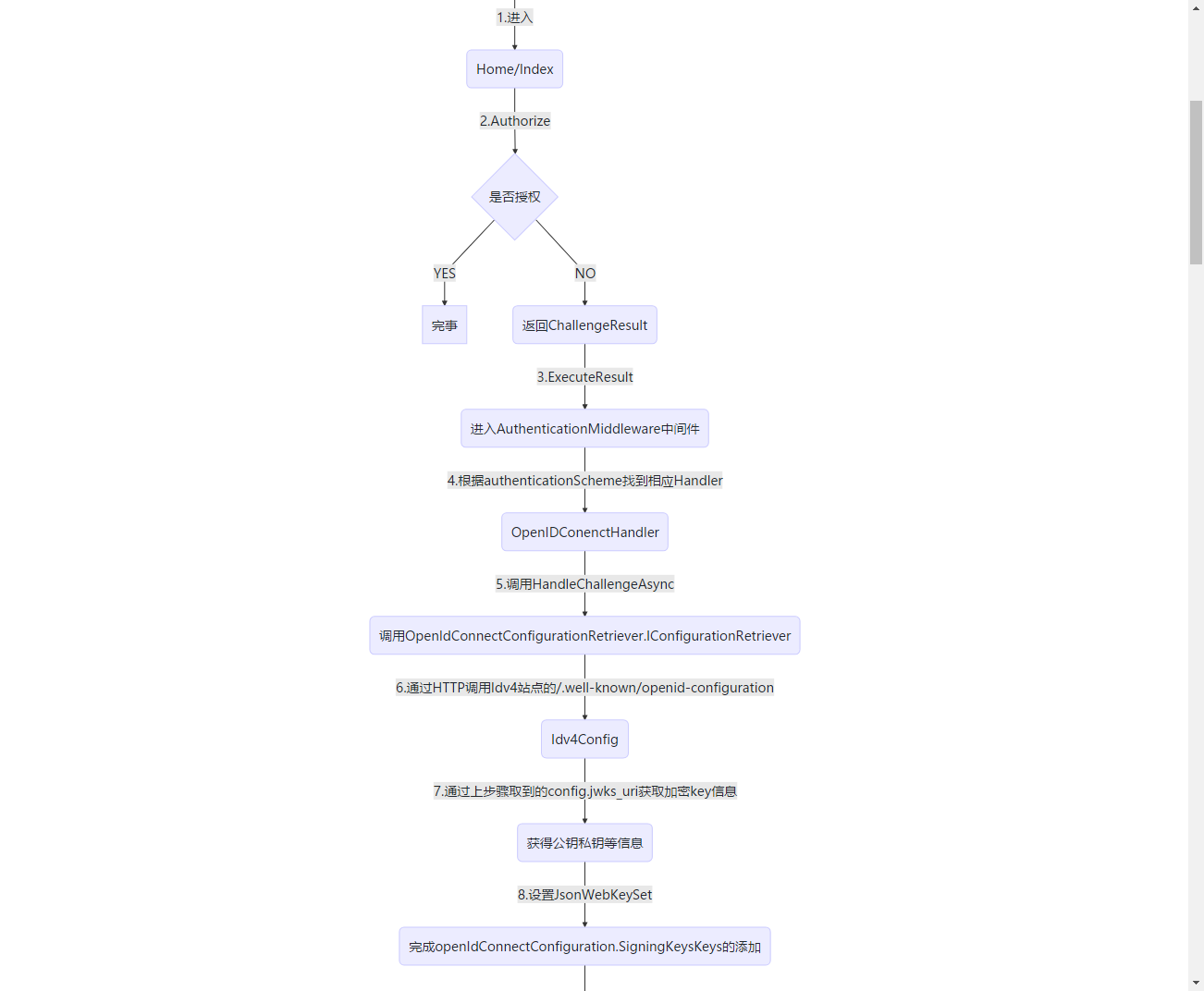IdentityServer4环境部署失败分析贴(一)
前言:
在部署Idv4站点和其客户端在外网时,发现了许多问题,折腾了许久,翻看了许多代码,写个MD记录一下。
1.受保护站点提示错误: Unable to obtain configuration from: '[PII is hidden]'.
fail: Microsoft.AspNetCore.Server.Kestrel[13]
Connection id "0HLL3MB34N0G5", Request id "0HLL3MB34N0G5:00000009": An unhandled exception was thrown by the application.
System.InvalidOperationException: IDX20803: Unable to obtain configuration from: '[PII is hidden]'.
在 Microsoft.IdentityModel.Protocols.ConfigurationManager`1.<GetConfigurationAsync>d__24.MoveNext()
--- 引发异常的上一位置中堆栈跟踪的末尾 ---
在 System.Runtime.ExceptionServices.ExceptionDispatchInfo.Throw()
在 System.Runtime.CompilerServices.TaskAwaiter.HandleNonSuccessAndDebuggerNotification(Task task)
在 Microsoft.AspNetCore.Authentication.OpenIdConnect.OpenIdConnectHandler.<HandleChallengeAsync>d__18.MoveNext()
--- 引发异常的上一位置中堆栈跟踪的末尾 ---
在 System.Runtime.ExceptionServices.ExceptionDispatchInfo.Throw()
在 System.Runtime.CompilerServices.TaskAwaiter.HandleNonSuccessAndDebuggerNotification(Task task)
在 Microsoft.AspNetCore.Authentication.AuthenticationHandler`1.<ChallengeAsync>d__54.MoveNext()
--- 引发异常的上一位置中堆栈跟踪的末尾 ---
1.1 受保护站点的代码执行流程
graph TB
User--1.进入-->A(Home/Index)
A--2.Authorize-->AA{是否授权}
AA--YES-->完事
AA--NO-->B(返回ChallengeResult)
B--3.ExecuteResult-->C(进入AuthenticationMiddleware中间件)
C--4.根据authenticationScheme找到相应Handler-->D(OpenIDConenctHandler)
D--5.调用HandleChallengeAsync-->F(调用OpenIdConnectConfigurationRetriever.IConfigurationRetriever)
F--6.通过HTTP调用Idv4站点的/.well-known/openid-configuration-->F1(Idv4Config)
F1--7.通过上步骤取到的config.jwks_uri获取加密key信息-->F2(获得公钥私钥等信息)
F2--8.设置JsonWebKeySet-->F3(完成openIdConnectConfiguration.SigningKeysKeys的添加)
F3-->F4(完成)

1.1 受保护站点的部分源码
Idv4部分源码
//注入Idev相关,配置authenticationScheme为oidc
public static IIdentityServerBuilder AddIdentityServer(this IServiceCollection services, Action<IdentityServerOptions> setupAction)
{
services.Configure(setupAction);
return services.AddIdentityServer();
}
PS: 这里要额外提一下,在Abp的模板项目中,如下配置使用Idv4可能无法正常跳转IDV4授权站完成单点登录
services.AddOpenIdConnect("oidc", options =>
{
...
}
需要额外添加下面这段,原因是Abp引入Microsoft.Identity,会重复设置schme导致错误,需如下代码添加设置。
services.AddAuthentication(options =>
{
options.DefaultAuthenticateScheme = "oidc";
options.DefaultChallengeScheme = "oidc";
options.DefaultSignOutScheme = "oidc";
})
步骤5部分源码
protected override async Task HandleChallengeAsync(AuthenticationProperties properties)
{
Logger.EnteringOpenIdAuthenticationHandlerHandleUnauthorizedAsync(GetType().FullName);
// order for local RedirectUri
// 1. challenge.Properties.RedirectUri
// 2. CurrentUri if RedirectUri is not set)
if (string.IsNullOrEmpty(properties.RedirectUri))
{
properties.RedirectUri = CurrentUri;
}
Logger.PostAuthenticationLocalRedirect(properties.RedirectUri);
if (_configuration == null && Options.ConfigurationManager != null)
{
//问题在这里
_configuration = await Options.ConfigurationManager.GetConfigurationAsync(Context.RequestAborted);
}
...
步骤6部分源码
public static async Task<OpenIdConnectConfiguration> GetAsync(string address, IDocumentRetriever retriever, CancellationToken cancel)
{
if (string.IsNullOrWhiteSpace(address))
throw LogHelper.LogArgumentNullException(nameof(address));
if (retriever == null)
{
throw LogHelper.LogArgumentNullException(nameof(retriever));
}
//当站点没启动的时候,这里可能出现问题
string doc = await retriever.GetDocumentAsync(address, cancel).ConfigureAwait(false);
LogHelper.LogVerbose(LogMessages.IDX21811, doc);
OpenIdConnectConfiguration openIdConnectConfiguration = JsonConvert.DeserializeObject<OpenIdConnectConfiguration>(doc);
if (!string.IsNullOrEmpty(openIdConnectConfiguration.JwksUri))
{
LogHelper.LogVerbose(LogMessages.IDX21812, openIdConnectConfiguration.JwksUri);
//当证书配置或读取错误的时候,这里会出现问题
string keys = await retriever.GetDocumentAsync(openIdConnectConfiguration.JwksUri, cancel).ConfigureAwait(false);
LogHelper.LogVerbose(LogMessages.IDX21813, openIdConnectConfiguration.JwksUri);
openIdConnectConfiguration.JsonWebKeySet = JsonConvert.DeserializeObject<JsonWebKeySet>(keys);
foreach (SecurityKey key in openIdConnectConfiguration.JsonWebKeySet.GetSigningKeys())
{
openIdConnectConfiguration.SigningKeys.Add(key);
}
}
return openIdConnectConfiguration;
}
通过流程进行问题解析:
通过查看日志可发现在流程5后开始报错
步骤一
访问:http://{ssoHost}/.well-known/openid-configuration
如果访问成功,则排除单点登录站点部署失败问题,前往步骤二
如果访问失败,则去解决单点登录站点部署问题。
步骤二
http://{ssoHost}/.well-known/openid-configuration/jwks
如果访问成功,则重启客户端
如果访问失败,那么有意思了...继续往下看
此时单点登录站点的日志
[10:25:24 Error] Microsoft.AspNetCore.Diagnostics.ExceptionHandlerMiddleware
An unhandled exception has occurred while executing the request.
Internal.Cryptography.CryptoThrowHelper+WindowsCryptographicException: 出现了内部错误。
at Internal.Cryptography.Helpers.OpenStorageProvider(CngProvider provider)
at System.Security.Cryptography.CngKey.Import(Byte[] keyBlob, String curveName, CngKeyBlobFormat format, CngProvider provider)
at System.Security.Cryptography.CngKey.Import(Byte[] keyBlob, CngKeyBlobFormat format)
at Internal.Cryptography.Pal.X509Pal.DecodePublicKey(Oid oid, Byte[] encodedKeyValue, Byte[] encodedParameters, ICertificatePal certificatePal)
at System.Security.Cryptography.X509Certificates.PublicKey.get_Key()
at Microsoft.IdentityModel.Tokens.X509SecurityKey.get_PublicKey()
at IdentityServer4.ResponseHandling.DiscoveryResponseGenerator.CreateJwkDocumentAsync()
at IdentityServer4.Endpoints.DiscoveryKeyEndpoint.ProcessAsync(HttpContext context)
at IdentityServer4.Hosting.IdentityServerMiddleware.Invoke(HttpContext context, IEndpointRouter router, IUserSession session, IEventService events)
at IdentityServer4.Hosting.IdentityServerMiddleware.Invoke(HttpContext context, IEndpointRouter router, IUserSession session, IEventService events)
at Microsoft.AspNetCore.Authentication.AuthenticationMiddleware.Invoke(HttpContext context)
at IdentityServer4.Hosting.BaseUrlMiddleware.Invoke(HttpContext context)
at Microsoft.AspNetCore.StaticFiles.StaticFileMiddleware.Invoke(HttpContext context)
at Microsoft.AspNetCore.Diagnostics.ExceptionHandlerMiddleware.Invoke(HttpContext context)
单点登录站点在此时的工作流程
graph TB
A(通过Http获取发现服务的配置信息)--1.进入SSO站点-->B(IdentityServerMiddleware)
B--2.调用Process-->C(进入DiscoveryKeyEndpoint)
C--3.遍历注入的加密Key-->D(返回JsonBWebKey)
部分源码解析:

public async Task Invoke(HttpContext context, IEndpointRouter router, IUserSession session, IEventService events)
{
// this will check the authentication session and from it emit the check session
// cookie needed from JS-based signout clients.
await session.EnsureSessionIdCookieAsync();
try
{
//根据请求路径,进入相应endpoint处理器
var endpoint = router.Find(context);
if (endpoint != null)
{
_logger.LogInformation("Invoking IdentityServer endpoint: {endpointType} for {url}", endpoint.GetType().FullName, context.Request.Path.ToString());
var result = await endpoint.ProcessAsync(context);
...
//创建JwtDocument
public virtual async Task<IEnumerable<Models.JsonWebKey>> CreateJwkDocumentAsync()
{
var webKeys = new List<Models.JsonWebKey>();
var signingCredentials = await Keys.GetSigningCredentialsAsync();
var algorithm = signingCredentials?.Algorithm ?? Constants.SigningAlgorithms.RSA_SHA_256;
foreach (var key in await Keys.GetValidationKeysAsync())
{
if (key is X509SecurityKey x509Key)
{
var cert64 = Convert.ToBase64String(x509Key.Certificate.RawData);
var thumbprint = Base64Url.Encode(x509Key.Certificate.GetCertHash());
//当证书读取不正常的时候,PublicKey的属性构造器中会报错。
var pubKey = x509Key.PublicKey as RSA;
var parameters = pubKey.ExportParameters(false);
var exponent = Base64Url.Encode(parameters.Exponent);
var modulus = Base64Url.Encode(parameters.Modulus);
var webKey = new Models.JsonWebKey
{
kty = "RSA",
use = "sig",
kid = x509Key.KeyId,
x5t = thumbprint,
e = exponent,
n = modulus,
x5c = new[] { cert64 },
alg = algorithm
};
webKeys.Add(webKey);
continue;
}
问题解析
通过日志可发现,问题出现在PublicKey的获取上,即证书的读取失败了。
解决方案!
终于到解决问题的时候了...
步骤一:
检查证书是否是临时证书
//在正式环境中,这可能会报错
builder.AddDeveloperSigningCredential(true, "tempkey.rsa");
//正确方式
builder.AddSigningCredential(new X509Certificate2(path,
Configuration["Certificates:Password"]))
这里可以参见郭的随笔:
https://www.cnblogs.com/guolianyu/p/9872661.html
步骤二:
如果已经添加了证书,且证书路径正确读取,且证书密码正确;
但是!在Windows Server2008服务器上部署仍失败时,请检查 CNG Key Isolation 服务是否启动!
如果 该服务未启动,则启动后即可!

如果该服务已启动,则尴尬的很...如果您仍排除不了问题,可以评论告诉我




